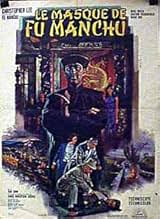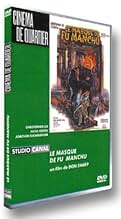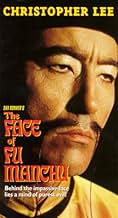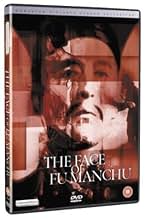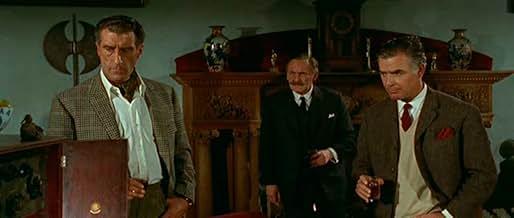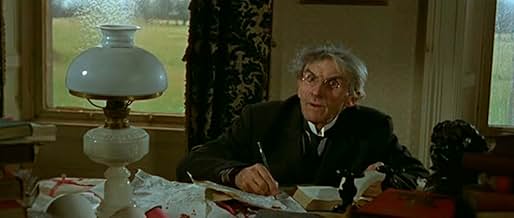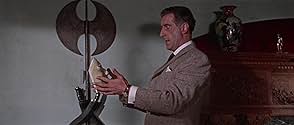VALUTAZIONE IMDb
5,8/10
2141
LA TUA VALUTAZIONE
Aggiungi una trama nella tua linguaAfter cheating death, master criminal Dr. Fu Manchu returns with a plot to contaminate the River Thames with a powerful toxin extracted from Tibetan poppies.After cheating death, master criminal Dr. Fu Manchu returns with a plot to contaminate the River Thames with a powerful toxin extracted from Tibetan poppies.After cheating death, master criminal Dr. Fu Manchu returns with a plot to contaminate the River Thames with a powerful toxin extracted from Tibetan poppies.
- Regia
- Sceneggiatura
- Star
Howard Marion-Crawford
- Dr. Petrie
- (as Howard Marion Crawford)
Francesca Tu
- Lotus
- (as Poulet Tu)
Peter Mosbacher
- Hanumon
- (as Peter Mossbacher)
Ric Young
- Grand Lama
- (as Eric Young)
Deborah DeLacey
- Slave Girl
- (as Deborah De Lacey)
Recensioni in evidenza
'The Face Of Fu Manchu' is the first in a series of five movies produced by the legendary Harry Allan Towers. Towers is probably best known for his collaborations with Jess Franco, indeed Franco directed the last two movies in the series, but this one is directed by Don Sharp ('Rasputin: The Mad Monk', 'Psychomania') and scripted by Towers himself. Horror legend Christopher Lee plays the fiendish Dr Fu Manchu, super criminal, and Nigel Green ('Zulu', 'Countess Dracula') plays his nemesis Sir Nayland Smith. Towers plays fast and loose with Sax Rohmer's original characters and stories with entertaining results. The main reason the movie works is because of the performances by Lee and especially Green, who is just terrific. The plot concerns the kidnapping of a German scientist (played by Joachim Fuchsberger) who Fu Manchu forces to develop a super weapon. The lovely Karin Dor ('You Only Live Twice') plays the scientist's daughter, Tsai Chin is Fu Manchu's evil daughter Lin Tang, and Howard Marion-Crawford is Nayland Smith's Watson-like sidekick Dr. Petrie. 'The Face Of Fu Manchu' isn't a great movie by any means but it's fun to watch, and a great way to spend a rainy afternoon.
Since 1923, Sax Rohmer's arch-villain Fu Manchu had been brought from the novels to the screen again and again, the most famous interpretation probably created by Boris Karloff in 1932. Between 1965-68, Christopher Lee starred in 5 more Fu Manchu movies. The German co-producers often added stars from the Edgar Wallace series, such as Joachim Fuchsberger and Karin Dor when the new series opened with "The Face of Fu Manchu". Strangely enough, it begins as if it was a sequel to something, describing Fu Manchu faking his execution while Nayland Smith watches, although we are not told how they got into this situation. Anyway, Fu Manchu comes to London with a weapon of mass destruction, while Smith tries to stop him. Smith had a feeling" from the beginning that he was cheated at the execution, but it was not completely reasonable for a man like him, since the first hints at new activities were vague. So I thought he might have been be a bit more surprised when he actually meets the criminal mastermind. The last third of the movie is a bit rushed, especially the scenes in Tibet. It is not a perfect movie because it has a few holes, but it was a good start for the new series. I voted 7/8/5/7/4 for the five movies.
Hit and run independent film financier Harry Alan Towers made his bid for the big time in 1965. Spending more money than he ever had (or would) again, scouting attractive international locations, hiring respected craftsmen and actors and launching a multi-million dollar publicity campaign to promote his pet project. "The Face of Fu Manchu", the unlikely recipient of all this attention, represents a plateau to which Towers would never aspire again.
After publicly purchasing the pulp adventure novels of Sax Rohmer, Towers signed horror film icon Christopher Lee to a six-picture deal as the title menace. As director, Towers hired Don Sharp, maker of numerous elegant, effective horror films and probably the most talented director to put his name on a Towers contract. Writing the script himself under his nom de cinema Peter Welbeck, Towers ignored the plots of all the Rohmer novels and concocted his own. The film wisely retains the period setting of early-twentieth century London (which required shooting in Dublin, for the sake of authenticity), but alters the deductive tone of the books in favor of action sequences in the style of the James Bond films, which were then in their first flush of international success.
The finished film is beautiful to see, filmed in technicolor and cinemascope, it truly looks more expensive than it is. Encouraged, Towers launched an expensive international publicity campaign whose most notable stunt was wallpapering election-year New York City with oversized "Fu Manchu For Mayor" posters
In the end, "Face" failed to return enough money to justify the huge outlay spent in making and promoting it. The film seemed to please no one: fans of the series were outraged by the James Bondian gunplay, fights and car chases, while Bond fans were alienated by the period trappings (1920s cars just don't go that fast!). More likely, this type of film just did not have the potential to reach the mainstream audience needed to make it a success.
Although Towers continued the series, the films would steadily decline in quality, from the high point of "Face" to the home-movie calibre of the final entry, "Castle of Fu Manchu".
After publicly purchasing the pulp adventure novels of Sax Rohmer, Towers signed horror film icon Christopher Lee to a six-picture deal as the title menace. As director, Towers hired Don Sharp, maker of numerous elegant, effective horror films and probably the most talented director to put his name on a Towers contract. Writing the script himself under his nom de cinema Peter Welbeck, Towers ignored the plots of all the Rohmer novels and concocted his own. The film wisely retains the period setting of early-twentieth century London (which required shooting in Dublin, for the sake of authenticity), but alters the deductive tone of the books in favor of action sequences in the style of the James Bond films, which were then in their first flush of international success.
The finished film is beautiful to see, filmed in technicolor and cinemascope, it truly looks more expensive than it is. Encouraged, Towers launched an expensive international publicity campaign whose most notable stunt was wallpapering election-year New York City with oversized "Fu Manchu For Mayor" posters
In the end, "Face" failed to return enough money to justify the huge outlay spent in making and promoting it. The film seemed to please no one: fans of the series were outraged by the James Bondian gunplay, fights and car chases, while Bond fans were alienated by the period trappings (1920s cars just don't go that fast!). More likely, this type of film just did not have the potential to reach the mainstream audience needed to make it a success.
Although Towers continued the series, the films would steadily decline in quality, from the high point of "Face" to the home-movie calibre of the final entry, "Castle of Fu Manchu".
In the light of its considerable reputation, this is a big disappointment. It's the old tale of Fu Manchu, the Yellow Peril, trying to take over the world. The racism of this is so self-evident it's probably not worth mentioning, although the blazing red whenever the Chinese are around, and the worker-like garb of Manchu's henchmen, suggest some sort of allegory of Communism - or is this story of a megalomaniacal, world-domination-lusting, Chinaman a parody of such portentousness?
I really wanted to like this film, but there's so much wrong with it. It's been called a spoof, but if so, the joke's on me. The 1920s setting is somewhat rudimentary - a few contemporary cars and hats in what looks like a very 1960s London (although the reviewer below suggests it is in fact Dublin). Far from camp, the plot is played so straight as to be unenjoyable. Every absurdity and implausibility, rather than hurtling us into the giddy realms of fantasy, rather lumbers us in a plot of cliched hackery.
The acting is abysmal - I've never gotten the point of Christopher Lee (he never had Peter Cushing's middle-aged anguish), although his plummy English tones in the supposed role of a fiendish Chinaman, offers some amusement, as does his daft moustache; worst of all is Nigel Green as the oaklike hero, Nayland Smith - a man so unexpressive and graceless should be funny, but here is dull, slowing down the film at every turn. Only FU Manchu's very sexy daughter, Tsai Chin, enthralls, her subservience to her father suggesting perverse depths of sado-masochism.
This is all the more frustrating in that the film has merit in abundance. The colour schemes, costumes, set-designs and compositions are frequently gorgeous, if sometimes let down by leaden direction; the afoementioned incestuous undertones in the relationship between Fu and daughter; a splendid ironising, despite the racism, of the noble West - Nayland Smith is quite clearly insane, and with his Chinese ladyservant, and death mask ornaments, seems more of a mirror image than a foil for Fu Manchu (there is also something wrong with chemists that research into a concoction that can wipe out whole peoples - there is a RIVER KWAI-like frisson in the plight of the Professor who ironically, and enthusiastically, aids his captor); there is a splendidly directed and designed car chase, reminiscent, as Tom Milne notes, of silent serials.
Best of all is the setting of this grotesque potboiler in placid England. This discrepancy gives the film an AVENGERS-like chill on occasion, especially the amazing scene where Fu Manchu first exercises his power, and wipes out an entire village - spinetingling, chilling, and much more frightening than a similar scene in GOLDFINGER.
I really wanted to like this film, but there's so much wrong with it. It's been called a spoof, but if so, the joke's on me. The 1920s setting is somewhat rudimentary - a few contemporary cars and hats in what looks like a very 1960s London (although the reviewer below suggests it is in fact Dublin). Far from camp, the plot is played so straight as to be unenjoyable. Every absurdity and implausibility, rather than hurtling us into the giddy realms of fantasy, rather lumbers us in a plot of cliched hackery.
The acting is abysmal - I've never gotten the point of Christopher Lee (he never had Peter Cushing's middle-aged anguish), although his plummy English tones in the supposed role of a fiendish Chinaman, offers some amusement, as does his daft moustache; worst of all is Nigel Green as the oaklike hero, Nayland Smith - a man so unexpressive and graceless should be funny, but here is dull, slowing down the film at every turn. Only FU Manchu's very sexy daughter, Tsai Chin, enthralls, her subservience to her father suggesting perverse depths of sado-masochism.
This is all the more frustrating in that the film has merit in abundance. The colour schemes, costumes, set-designs and compositions are frequently gorgeous, if sometimes let down by leaden direction; the afoementioned incestuous undertones in the relationship between Fu and daughter; a splendid ironising, despite the racism, of the noble West - Nayland Smith is quite clearly insane, and with his Chinese ladyservant, and death mask ornaments, seems more of a mirror image than a foil for Fu Manchu (there is also something wrong with chemists that research into a concoction that can wipe out whole peoples - there is a RIVER KWAI-like frisson in the plight of the Professor who ironically, and enthusiastically, aids his captor); there is a splendidly directed and designed car chase, reminiscent, as Tom Milne notes, of silent serials.
Best of all is the setting of this grotesque potboiler in placid England. This discrepancy gives the film an AVENGERS-like chill on occasion, especially the amazing scene where Fu Manchu first exercises his power, and wipes out an entire village - spinetingling, chilling, and much more frightening than a similar scene in GOLDFINGER.
Undoubtedly the best of the series of Fu Manchu films produced in the late 60s, well cast and well directed by Don Sharp, who commendably eschewed camp 'Boys Own' heroics to produce a gripping adventure-thriller. Christopher Lee (as one would expect) is suitably menacing and inscrutable as Fu Manchu, even though the emphasis on his hypnotic eyes is an obvious reference to his role as Dracula. The ever-reliable Nigel Green (Zulu)turns in a solid 'Holmes-ian' performance as Fu Manchu's nemesis Nayland Smith, while James Robertson Justice has a memorable cameo as an irascible museum curator.
The highpoint of the film is undoubtedly the chilling sequence set in a English village, where all the inhabitants have been killed by poisoned gas. It still sends a shiver up the spine. The first sequel, Brides of Fu Manchu, with Douglas Wilmer as Nayland Smith, is watchable, even though it is basically a retread of the first movie, but the films which followed (especially the two directed by the notorious Jess Franco)are absolutely dire.
The highpoint of the film is undoubtedly the chilling sequence set in a English village, where all the inhabitants have been killed by poisoned gas. It still sends a shiver up the spine. The first sequel, Brides of Fu Manchu, with Douglas Wilmer as Nayland Smith, is watchable, even though it is basically a retread of the first movie, but the films which followed (especially the two directed by the notorious Jess Franco)are absolutely dire.
Lo sapevi?
- QuizChristopher Lee wrote in his memoirs, how his leading lady Tsai Chin assisted him with memorizing the Cantonese dialogue.
- BlooperAs the two soldiers stop for a cup of tea, one leans his rifle against the table behind them. It then slowly falls over, totally ignored by the two men as they discuss the weather.
- Versioni alternativeWhen originally released theatrically in the UK, the BBFC made cuts to secure a 'U' rating. All cuts were waived in 1991 when the film was granted a 'PG' certificate for home video.
- ConnessioniFeatured in London Labyrinth (1993)
I più visti
Accedi per valutare e creare un elenco di titoli salvati per ottenere consigli personalizzati
- How long is The Face of Fu Manchu?Powered by Alexa
Dettagli
- Data di uscita
- Paesi di origine
- Lingue
- Celebre anche come
- The Face of Fu Manchu
- Luoghi delle riprese
- Skerries, Fingal, County Dublin, Irlanda(Fleetwick)
- Aziende produttrici
- Vedi altri crediti dell’azienda su IMDbPro
Botteghino
- Lordo Stati Uniti e Canada
- 2.834.000 USD
- Tempo di esecuzione1 ora 29 minuti
- Proporzioni
- 2.35 : 1
Contribuisci a questa pagina
Suggerisci una modifica o aggiungi i contenuti mancanti

Divario superiore
By what name was Fu Manciù A.S.3: Operazione Tigre (1965) officially released in India in English?
Rispondi


